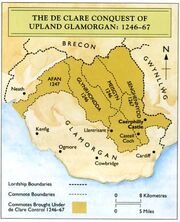
Banner of the Princes of Glamorgan
The Princes of Morgannwg were created as the junior level of the Tripartite principality system introduced by King Owain V.
In 1487, by the Statute of Harlech, the three principalities of Gwynedd, Powys and Morgannwg were brought back to political life. The case for Gwynedd and Powys were clear. The King needed a strong base to provide financial security for the crown. To that end, historic Gwynedd was the obvious choice. Powys, being the ancestral principality of the Glyndwr family was brought back and entrusted to the kings son, Prince Maredudd. Morgannwg was not the obvious third principality. Dehubarth had an older, more respected claim, and again, the King had an ancestral link to that House. However, the most successful invasions of Wales had all followed the same route. That route being through South Wales. A strong lord would not only aid the king in providing strong control over the entire kingdom, but would also act as an initial bulwark should the English invade. The only question remaining to Owain was, to which family should the honour of Morgannwg be bestowed.
The House of Bren []

Map of Glamorgan showing the lands of Senghennydd
In the end, Owain opted for the Lords of Senghenydd. The family had long held the lands north of Caerphilly and Lord Iolo Bren (1380-1443) had fought alongside Owain Glyndwr in the First War of Independence. The House of Bren descended from Meurig Senghenydd who held land in the north of the area. Meurig was one of the last truly independent Morgannwg lords, with his son Ifor Bach continuing this independent line. Iolo Brens Great-Grandfather, Llywelyn Bren (1267-1318) was the last of the Southern Lords to mount a serious challenge to the English (during the reign of Edward II). It was this streak of independence along with the actions of Iolo during the First War of Independence which secured from the king the Grant of Honour which raised the family to the Principality of Morgannwg.
The last Lord of Senghenydd (Gwillym Bren 1443-84) was an ambitious man. The chance to empower his family within the newly independent Wales was one he took with both hands. Gwillym himself married Angharad Mortimer, daughter of Edmund Mortimer (brother in law to Owain Glyndwr). His children would therefore be descended from kings of England and the House of Mathrafal. Gwillym himself was descended from the House of Aberffraw via his mother (Lady Angharad ferch Gruffud Fychan). She was a descendent of one of Dafydd III of Wales' illegitimate sons (Dafydd Goch). From earlier generations Gwillym was also descended from William the Conqueror and Hywel Dda. With such a wide cast of Royal ancestors, Gwillym lobbied hard for the honour of raising his family to the Princedom of Morgannwg.
List of Lords of Senghenydd (Dates of Reign)[]
- Meurig Senghenydd
- Ifor Bach (-1170)
- Gruffudd ap Ifor Bach (1170 - 1211)
- Rhys ap Gruffudd ap Ifor Bach
- Gruffudd ap Rhys Bach (-1268)
- Llywelyn Bren (-1318)
- Gruffudd ap Llywelyn Bren (1318-1350)
- Meurig Bren (1350-1386)
- Rhys Bren (1386-1404)
- Iolo Bren (1404-1443)
- Gwillym Bren (1443-1484)
- Gwillym Bren (1484-1502)
List of Princes of Morgannwg (Dates of Reign)[]
House of Bren[]
- Gwillym I Bren (1487-1502)
- Cystennin I Bren (1502-1519)
- Dafydd I Bren (1519-1552)
- Heledd Morgannwg (1552-1582)
House of Morgannwg[]
- Gwillym II Morgannwg - Son of Dafydd I (1582-1601)
- Meurig Morgannwg (1601-1660)
- Iago I Morgannwg (1660-1673)
- Cystennin II Morgannwg (1673-1733)
- Rhisiart I Morgannwg (1733-1773) - Also King Rhisiart I of Wales
- Rhisiart II Morgannwg (1773-1795) - Also King Rhisiart II of Wales
- Arthur I Morgannwg (1795-1831) - Also King Arthur I of Wales
- Cystennin III Morgannwg (1831-1845) - Also King Cystennin of Wales
- Rhisiart III Morgannwg (1845-1870) - Also King Rhisiart III of Wales
- Rhisiart IV Morgannwg (1870-1904) - Also King Rhisiart IV of Wales
- Iorwerth Morgannwg (1904-1920) - Also King Iorwerth of Wales
- Iago II Morgannwg (1920-1942) - Also King Iago of Wales
- Owain Morgannwg (1942-1944) - Also Edling Cymru (Crown Prince of Wales)
- Marged Morgannwg (1944-1950) - Also Queen Marged of Wales 1950-1959 - Daughter of Iorwerth
House of Oldenburg-Morgannwg[]
- Arthur II Oldenburg-Morgannwg (1950-1964) - Also King Arthur II of Wales 1959-1982
- Llywelyn I Oldenburg-Morgannwg (1964-1985) - Also King Llywelyn III of Wales 1982- Present
- Owain II Oldenburg-Morgannwg (1985- Present) - Also Edling Cymru (Crown Prince of Wales)
Titles & Styles of Tywysogion Morgannwg[]
The Tywysogion Morgannwg is referred to as the Arglwyddiaeth Fawr Morgannwg (Great Lordship of Morgannwg), also called Yr Urddas Morgannwg (The Dignity of Morgannwg). The use of the phrase "Yr Urddas Mogannwg" grew in prominence following the Ail Rhyfel Annibyniaeth (2nd War of Independence), although both continue to be used on official siarteri tywysogaidd (princely charters) with such styles as "siarter hon, a gyhoeddwyd yn enw'r Owain, Ei Uchelder Tangnefeddus, Tywysog Arglwyddiaeth Fawr ac Urddas Morgannwg" (this charter, issued in the name of Owain, His Serene Highness, Prince of the Great Lordship & Dignity of Glamorgan)
In the same manner as the tywysogian Powys and Gwynedd, the Tywysogion Morgannwg were traditionally styled "Ei Uchelder Tangnefeddus, X Tywysog Morgannwg" (His/Her Serene Highness, X the Prince/ess of Powys).
As the ruling family in Cymru, the Tywysog Morgannwg is also the Edling Cymru and therefore entitled to use ei uchelder brenhinol (his/her royal highness) and therefore their style is "Ei Uchelder Brenhinol ac Tangnefeddus, X Tywysog Morgannwg" (His Royal & Serene Highness, X, Prince of Morgannwg). For all issues relating to the their actions as Prince of Morgannwg, the title of Edling Cymru is not used.
Subsidary Titles to the Prince of Morgannwg[]
- Ardalydd Ogwr (Alternative Welsh style of Marcwis)
- Is-Iarll Ruthin
- Barwn Cibwr
- Arglwydd Cynffig
List of Tywysogion Morgannwg[]
- Gwillym I Bren
- Cystennin I Bren
- Dafydd I Bren
- Heledd Morgannwg
- Gwillym II Morgannwg
- Meurig Morgannwg
- Iago I Morgannwg
- Cystennin II Morgannwg
- Rhisiart I Morgannwg
- Rhisiart II Morgannwg
- Arthur I Morgannwg
- Cystennin III Morgannwg
- Rhisiart III Morgannwg
- Rhisiart IV Morgannwg
- Iorwerth Morgannwg
- Iago II Morgannwg
- Owain Morgannwg
- Marged Morgannwg
- Arthur II Oldenburg-Morgannwg
- Llywelyn I Oldenburg-Morgannwg
- Owain II Oldenburg-Morgannwg - Heir is EUB Gruffydd, Pendefig Cymru, Ardalydd Ogwr
The Royal Seat - Senghenydd Palace[]
The Princes of Morgannwg came originally from the Lords of Senghenydd, who had their seat of power near to the English town of Caerphilly. From the time of Iolo Bren, Lord of Senghenydd, the family resided in what became known as Senghenydd House, built on the outskirts of Caerphilly. During the reign of Dafydd the First of Morgannwg work began on modernising the house in the German style. By the end of his daughters reign (Heledd in 1582) the house was now referred to as Senghenydd Palace.

Senghenydd Palace (16th Century)
This would be the home of the Princes until the time of Cystennin II of Morgannwg (Prince between 1673-1733) who began the work to again modernise the Palace. This work was interupted by the English Occupation during which time the Palace was used as the residence of the Anglo-Scots Army Commander. Following the rise of the House of Morgannwg as Welsh king and the Welsh Restoration, the Palace briefly re-emerged as the home of the Welsh Court. This ended with the move of the Royal Court to the Fortress & Palace of Caerphilly which remained the home of the Welsh Royal Family until the move to Cwm Hydref. The Palace of Senghenydd was retained as the Summer Palace of the Welsh kings during this period.
During the 20th Century the Palace was neglected until the outbreak of the Great War in 1939. The German Army took over the use of the Palace in 1937 using it as their headquarters in Wales. With the German expulsion and the placing of Iago under house arrest in Castell Coch, Field Marshall Thomas took over the Palace as his official residence. In 1942, with the separation of the Crown from the Principality of Morgannwg, Thomas signed the Palace over to the Edling, Owain, to be the seat of the Princes of Morgannwg separate to the Crown. This role has continued with the heir to the Welsh Throne now being Prince of Glamorgan in his or her own right owning the use of the Palace as their official residence.

Senghenydd Palace following the completion of restoration work
Today the Palace is open to the public during the summer and acts as the official residence for the Office of Prince of Morgannwg for Prince Owain II of Morgannwg.
